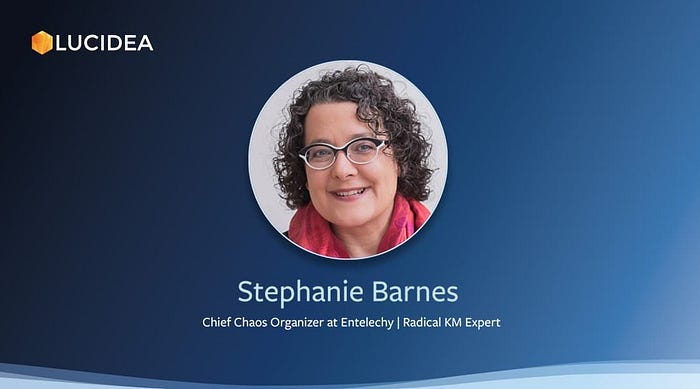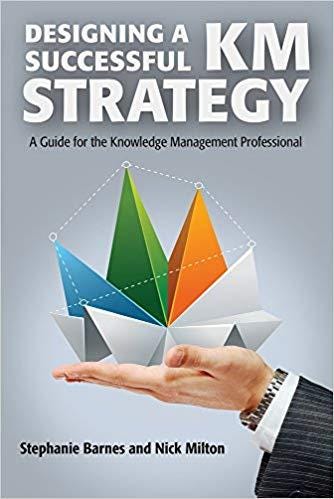Originally posted 07-Apr-22

Stephanie Barnes is a passionate advocate for knowledge management through the alignment of people, process, and technology to meet organizational goals and objectives. She works with organizations to solve problems in creative and innovative ways. Her website is Entelechy — The realization of potential.
Stephanie takes a radical approach to knowledge management. According to her LinkedIn profile, “Knowledge wants and needs curiosity and learning. Knowledge is context sensitive. Knowledge needs space and time. The things knowledge wants were educated out of us through production line thinking. What we need is to reintroduce the things that have been forgotten: creativity and playfulness. By reactivating these things, things we once instinctively knew, and infusing them into our work activities we are better able to adapt to an ever-evolving environment, and create organizations that are more innovative, flexible, and engaged. Radical Knowledge Management, it’s time to embrace the knowledge economy.”
Stephanie and I worked together as part of Hewlett-Packard’s knowledge management efforts. She was at HP from 1997 to 2003, leaving to start her own consultancy. Stephanie led the KM program for the HP Outsourcing business.

Profiles
Posts
SIKM Leaders Community
- Posts
- March 2024 Presentation: Radical Knowledge Management: Helping Humans in an AI World
- February 2012 Presentation: Aligning People, Process and Technology in KM
- December 2007 Presentation: Implementing KM in an ITIL Environment
Books
- Aligning People, Process and Technology in Knowledge Management
- Chapter in Measuring the ROI of Knowledge Management — Expert analysis 1: Return on investment and KM: Maximizing ROI, Reasons to measure ROI, Determining ROI, Conclusion
- Chapter in The Definitive Law Firm Management Guide 2nd Edition — Section H — Knowledge management: Make or buy: How to choose a KM system for your firm
Designing a Successful KM Strategy: A Guide for the Knowledge Management Professional with Nick Milton

Table of Contents
- Chapter 1 What Exactly Is Knowledge Management, and Why Do We Need It?
- Chapter 2 The Knowledge Manager Role
- Chapter 3 Making the Case for a Knowledge Management Strategy
- Chapter 4 The Ten Principles Behind Your KM Strategy
- Chapter 5 Strategy Structure, and Strategy Input
- Chapter 6 Identifying the Underlying Business Imperatives and Drivers
- Chapter 7 Knowledge Management Vision and Scope
- Chapter 8 Strategic Knowledge Areas 67 Identifying the Strategic Knowledge Areas
- Chapter 9 Assessing the Current State of KM in the Organization
- Chapter 10 Knowledge Management Framework
- Chapter 11 Information and Content Management
- Chapter 12 Knowledge Management Technology
- Chapter 13 Change Management
- Chapter 14 Stakeholders
- Chapter 15 Pilot Projects
- Chapter 16 Making the Business Case and Determining ROI
- Chapter 17 The Guerrilla Strategy
- Chapter 18 A Retention-Based Knowledge Management Strategy
- Chapter 19 Building the Implementation Team
- Chapter 20 Final Words
- Appendix A: Communication Plan Template
Videos
Other Content
- Publications
- SlideShare
- Radical Knowledge Management: Using Lessons Learned From Artists to Create Sustainable Workplaces
Change
Change is a big part of knowledge management (radical or otherwise), in reality, it’s a big part of just about anything we do and has come up a lot recently in conversations I’ve been having.
Change is hard when it’s forced, when it’s top-down, when people aren’t involved and don’t understand what’s happening and why; it’s hard when they are not engaged in the process.
So, how do you engage people in change?
The short answer is, you communicate with them, you engage them in discussions. Find out what their concerns are, how they would like to be involved, find out what their thoughts are about the change, maybe they see it as a good thing and want to get involved and help, maybe they aren’t sure or don’t have time. Talk to them and find out. Some of these conversations will be difficult and confrontational, be prepared for that and do them anyway. Be curious.
Communication (both ways, not top-down) is key to so many things and yet many of us are really bad at it. There are lots of books and courses that will help, if you want help. I’ve been reading about Nonviolent Communication lately, and I have read other books in the past. The key is to practice and get better at the techniques that the books/courses recommend and ultimately to do them in real life, something that can be challenging and difficult but very rewarding.
People will say, “I don’t have time”, but do you have time to fail? Time to do it again when it doesn’t work out? Do you really want to deal with the consequences of not trying: broken trust, broken relationships, etc.?
Take the time to talk to people, you won’t regret it, they will tell you what you need to be successful.
